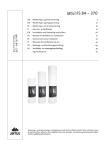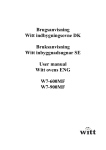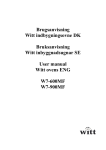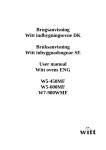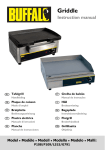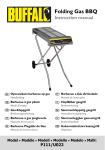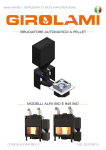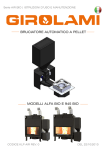Download CTX G-26 Technical data
Transcript
CONVEYOR OVEN TYPE: CTX G 26 Installation and Operation Manual S/N: Rev.: 2.0 12.4.2002 Rev. 2.0 Dear Customer, Congratulations on deciding to choose a Metos appliance for your kitchen activities. You made an excellent choice. We will do our best to make you a satisfied Metos customer like thousands of customers we have around the world. Please read this manual carefully. You will learn correct, safe and efficient working methods in order to get the best possible benefit from the appliance. The instructions and hints in this manual will give you a quick and easy start, and you will soon note how nice it is to use the Metos equipment. All rights are reserved for technical changes. You will find the main technical data on the rating plate fixed to the equipment. When you need service or technical help, please let us know the serial number shown on the rating plate. This will make it easier to provide you with correct service. For your convenience, space is provided below for you to record your local Metos service contact information. METOS TEAM Metos service phone number:............................................................................................... Contact person:.................................................................................................................... 12.4.2002 Rev. 2.0 12.4.2002 Rev. 1. General .......................................................................................................... 1 1.1 Symbols used in the manual .......................................................................................... 1 1.2 Symbols used on the appliance ...................................................................................... 1 1.3 Checking the relation of the appliance and the manual ................................................. 1 2. Safety .............................................................................................................. 2 2.1 Safe use of the appliance ............................................................................................... 2 2.2 Other prohibitions (dangerous procedures) ................................................................... 2 3. Functional description .................................................................................. 3 3.1 General .......................................................................................................................... 3.2 Construction .................................................................................................................. 3.2.1 Component Location .............................................................................................. 3.2.2 Component Function .............................................................................................. 3.3 Operating principle ........................................................................................................ 3.3.1 Operating switches and indicator lights ................................................................. 3 3 4 4 5 5 4. Operation instructions ................................................................................. 8 4.1 Before using the appliance ............................................................................................ 8 4.1.1 Infrared Cooking Technology ................................................................................ 8 4.1.2 Heat Zoning ........................................................................................................... 8 4.1.3 Cooking Trials ....................................................................................................... 9 4.2 Operation procedures ................................................................................................... 10 4.2.1 Operation of the G-26 MenuSelect Control Oven ............................................... 10 4.2.2 Cooking in a CTX Oven ...................................................................................... 11 4.2.3 Time and Temperature Guide .............................................................................. 12 4.2.4 Loading the Conveyor ......................................................................................... 15 4.3 After use ...................................................................................................................... 16 4.3.1 Cleaning .............................................................................................................. 16 5. Installation ................................................................................................... 20 5.1 Unpacking the oven ..................................................................................................... 5.1.1 Uncrating ............................................................................................................. 5.2 Installation ................................................................................................................... 5.2.1 Installing Legs ...................................................................................................... 5.2.2 Stacking and Mounting Two Ovens .................................................................... 5.2.3 Conveyor Belt and Temperature Display ............................................................ 5.2.4 Standoffs .............................................................................................................. 5.2.5 Pivoting Heat Curtains ......................................................................................... 5.2.6 Exit Tray .............................................................................................................. 20 21 22 22 22 24 24 25 25 12.4.2002 Rev. 5.3 Positioning the appliance ............................................................................................. 26 5.4 Electrical connections .................................................................................................. 26 5.5 Programming the G-26 MenuSelect Control Oven ..................................................... 27 6. Troubleshooting .......................................................................................... 29 8. Technical specifications .............................................................................. 39 12.4.2002 Rev. 2.0 General 1. General Carefully read the instructions in this manual as they contain important information regarding proper, efficient and safe installation, use and maintenance of the appliance. Keep this manual in a safe place for eventual use by other operators of the appliance. The installation of this appliance must be carried out in accordance with the manufacturer’s instructions and following local regulations. The connection of the appliance to the electric and water supply must be carried out by qualified persons only. Persons using this appliance should be specifically trained in its operation. Switch off the appliance in the case of failure or malfunction. The periodical function checks requested in the manual must be carried out according to the instructions. Have the appliance serviced by a technically qualified person authorized by the manufacturer and using original spare parts. Not complying with the above may put the safety of the appliance in danger. 1.1 Symbols used in the manual This symbol informs about a situation where a safety risk might be at hand. Given instructions are mandatory in order to prevent injury. This symbol informs about the right way to perform in order to prevent bad results, appliance damages or hazardous situations. This symbol informs about recommendations and hints that help to get the best performance out of the appliance. 1.2 Symbols used on the appliance This symbol on a part informs about electrical terminals behind the part. The removal of the part must be carried out by qualified persons only. 1.3 Checking the relation of the appliance and the manual The rating plate of the appliance indicates the serial number of the appliance. If the manuals are missing, it is possible to order new ones from the manufacturer or the local representative. When ordering new manuals it is essential to quote the serial number shown on the rating plate. 1 12.4.2002 Rev. 2.0 Safety 2. Safety 2.1 Safe use of the appliance For your safety. Do not store or use gasoline or other flammable vapors or liquids in the vicinity of this or any other appliance. 2.2 Other prohibitions (dangerous procedures) Using any parts other than genuine CTX factory manufactured parts relieves the manufacturer of all liability. Improper installation, adjustment, alteration, service or maintenance can cause property damage or major injury. Read the installation and operating instructions thoroughly before installing or servicing this equipment. 2 12.4.2002 Rev. 2.0 Functional description 3. Functional description 3.1 General Model G-26 ovens are: • • • • • 3.2 Electrically heated Heated by infrared panels MenuSelect Operated Conveyorized Electronically controlled Construction The oven features stainless steel exterior and an aluminized steel oven chamber. The conveyor is a 40 centimetres wide stainless steel chain link belt. It is equipped with four 10 cm high adjustable legs, heat curtains, crumb trays and exit trays. 3 12.4.2002 Rev. 2.0 Functional description 3.2.1 Component Location 8 7 6 1 5 2 1. 2. 3. 4. 5. 6. 7. 8. 3 4 10 cm Adjustable Legs Heat Curtain Crumb Tray Oven Data Plate, located under conveyor Conveyor Controls Conveyor Motor Control Compartment Cooling Fan 3.2.2 Component Function 1. 2. 3. 4. 4 Single and Stacked Ovens The CTX model G-26 is available as either a single oven or two ovens stacked. Each unit is supplied with four 10 cm adjustable legs. The legs must be used on single oven or lower oven of stacked oven to validate the warranty. The stacked oven is made up of two separate units, one on top of the other. Mounting pins (P/N G26STACK) must be installed when stacking two ovens, if pins are not used warranty will be voided. Cooking Area The CTX Model G-26 has a 660mm long cooking deck (chamber) with a 406mm wide conveyor belt. Controller The Controller controls both the temperature and conveyor belt speed (cook time) of the oven. Cook temperature can be set to from 93°C to 509°C and cook time can be set from 01:00 minute to 30:00 minutes. Infrared Heating Panels Patented heating panels are positioned above and below the conveyor belt of each oven deck (chamber). When energized these panels emit infrared long waves. 12.4.2002 Rev. 2.0 Functional description 5. These waves do not heat the air through which they pass. Instead the waves are absorbed by the outer surface of the product transported through the oven on the conveyor belt. Using this application food is placed on the conveyor and the unique properties of the infrared waves cause it to cook from the outside to the center in traditional fashion. Heat Zones The heat zones refer to individual areas of heat control within a cooking deck (chamber). The deck contains two heat zones (top and bottom). Top element Övre element Ylempi elementti Top zone Övre zon Ylempi paistoalue Bottom zone Nedre zon Alempi paistoalue Bottom element Nedre element Alempi elementti 6. 7. 3.3 Conveyor The conveyor is used to transport the product through the oven deck (chamber). the conveyor is made up of a frame and a stainless steel wire belt which can travel in either direction around the frame. The conveyor can travel at variable speeds and the speed is controlled by the Controller. The speed of the conveyor determines how long the product will be in the cooking chamber which is the cooking time. The oven chamber is 470mm wide with a 406mm wide conveyor belt. Accessories Kit For Stacking Two G-26’s. An accessory stacking pins kit (P/N G26STACK) allows you to stack two G-26’s one on top of the other (See Installation section). The pins must be used when stacking a G-26 or the warranty is voided. Instructions for stacking the ovens are also available in the stacking bracket kit. Operating principle The G-26 conveyor oven employs infrared cooking technology. Infrared heat panels are placed on above and one below the conveyor. These panels form the oven’s upper and lower heat zones. A controller accurately maintains set cooking temperatures and conveyor speed (cooktime) for consistent and repeatable results. Food is cooked by absorption of infrared waves as it is conveyed through the oven chamber. 3.3.1 Operating switches and indicator lights The control panel consists of an ON/OFF switch, a keypad with multi-function keys, a liquid crystal display, a keyoperated programming lockout switch, a conveyor reversing key switch and a circuit breaker. The following information provides a basic description of the oven’s controls, their locations and the function they perform. It is necessary the operator to be familiar with them. 5 12.4.2002 Rev. 2.0 Functional description 1 2 14 3 13 15 7 4 11 8 5 6 12 9 10 1. 2. 3. 6 POWER ON/OFF • Used to turn oven ON and OFF TOP TEMPERATURE • used to display actual temperature of the top zone when used in conjunction with the ACTUAL key. • used to display set temperature of the top zone during operation. • used to change set temperature of the top zone during programming. BOTTOM TEMPERATURE • used to display actual temperature of the bottom zone when used in conjunction with the ACTUAL key. • used to display set temperature of the top zone during operation. • used to change set temperature of the top zone during programming. 12.4.2002 Rev. 2.0 Functional description 4. 5. 6. 7. 8. 9. 10. 11. 12. 13. 14. 15. COOK TIME • used to display and/or change cook time setpoint of a preset menu. ACTUAL KEY • used to display actual temperature of either the top or bottom zone when used in conjunction with the TOP TEMP or BOTTOM TEMP keys. Cursor key • used to move the cursor to the next digit from left to right. Up Arrow key • used when programming to increase one number at a time 0 to 9 and then roll over to 0. Preset Menu keys 1-5 • used to operate or program oven in one of five preset menu modes. In the event of a power failure the oven will default back to the previously used preset menu when power is restored. Always check that the oven is in the desired mode when the power is restored. MANUAL OVERRIDE • used to temporarily override preset menu setting and operate oven at any desired temperature and cook time. CLEAN • used to enter the self-cleaning mode of oven. Programming Lockout Key Switch • used to lockout the preset menu select programmability when the key is in the horizontal position. Conveyor Reversing Key Switch • used to change the conveyor direction of travel. Display. Provides readout of data including: • data being entered • error and service information • set cook times • set and actual temperatures READY Light • when the READY light is on the oven has reached the set temperature. Circuit Breaker Reset Switch • provides circuit protection. Press to reset. 7 12.4.2002 Rev. 2.0 Operation instructions 4. Operation instructions 4.1 Before using the appliance Before you begin to cook with your new oven you must understand the differences between cooking in it and cooking in more conventional ovens. You will produce better results if you understand the technology and follow the “rules”. 4.1.1 Infrared Cooking Technology The technology of infrared cooking used in the CTX Gemini series ovens was first introduced by CTX in 1969. Each oven is fitted with patented infrared emitting heat panels (heating elements). These elements form the top and bottom surfaces of the oven chamber. The G-26 has two elements, one above and one below the conveyor belt. These elements emit infrared “long waves” which are absorbed by almost all matter in varying degrees. Absorption of these waves by an object causes molecular agitation which causes friction which generates heat. In this instance the object is food and the heat generated is used to cook the food. Infrared waves penetrate the outer surfaces of the food where they are absorbed by virtually all ingredients plus the container in which the food is placed. As a result, food cooks from the outside toward the center in very traditional fashion. Infrared waves, unlike conventional heat sources, do not heat the air through which they pass, nor do they create any air currents in the oven chamber to dry out the food product. If there is no food product in the oven the infrared waves are absorbed by the heating elements located opposite. These unique properties translate into less food waste, a more moist product and excellent energy efficiency. 4.1.2 Heat Zoning Since the top and bottom elements are controlled independently, they can be set anywhere in their range. This feature offers much more versatility than many other ovens. It enables the operator to raise only the bottom temperature to give the product a crisp hearth-baked appearance or to cook a product evenly through a heavy metal pan. Or the operator may choose to raise only the top element temperature to give a crisp or broiled top to a product. It is recommended that the top and bottom temperatures be set within 24°C of each other. Refer to the figure below. The elements are very efficient, and a temperature differential greater than 24°C will result in the lower temperature element being heated by the higher temperature element. This, in turn, causes an incorrect reading of temperatures and will result in an inconsistent product. 8 12.4.2002 Rev. 2.0 Operation instructions Top Element Överelement Yläelementti 24° max. differential Max. 24° ero Bottom element Nedre element Alaelementti 4.1.3 Cooking Trials The purpose of conducting cooking trials is to determine the exact temperature settings and cooking time(s) needed to produce best results with your specific product(s). The fastest and easiest way to conduct these trials is to start with settings already established for product(s) similar to yours. The following table provides average time and temperature settings for a wide variety of products. We recommend they be used as beginning set points for your tests. Testing can be completed easier and faster and with less confusion if you keep accurate records of each test. To assist you we have included a sample product test form that you can copy. Choose your first product for test and look it up in the table on the following pages. Now program the oven with the temperatures and cook times shown. If you are starting the oven from “cold” please allow 45 minutes heat up time. The elements cycle after approximately 15 minutes, however, additional time is needed for the oven chamber(s) to become stabilized and evenly saturated with heat. Begin your first trial run. Examine the finished product and evaluate it based on the following guidelines. RESULTS SOLUTION Outside too dark or burned Reduce Temperatures Outside too light or not cooked Increase Temperatures Inside Overdone or dried out Shorten Cooking Time Inside Underdone or raw Lengthen Cooking Time Sometimes an increase in temperature may require a corresponding decrease in cooking time. Conversely a decrease in temperature may require a corresponding increase in cooking time. 9 12.4.2002 Rev. 2.0 Operation instructions After evaluating the results, make the indicated time/temperature setting adjustments and allow about 15 minutes for the oven to stabilize at the new temperature settings. It may be necessary to run several tests before you obtain the exact results you want. Be sure to document each test in the “Product Test Record” below so you can ultimately produce a cooking chart for your specific items. Product 4.2 State Temp. Setting Top/Bott Cook Time (Min.) Pan Type Amount Cooking and Size (Weight or result Count) Operation procedures 4.2.1 Operation of the G-26 MenuSelect Control Oven 1. 2. 3. Turn oven deck ON Turn ON main disconnect switch at the wall box. Turn ON/OFF switch ON. To program a new preset menu selection Perform the procedure described in Programming the G-26 MenuSelect Control Oven section. At least one menu selection MUST be programmed before the oven can be operated. To choose a preset menu selection Press 4. (or any other preset menu key 1-5). The display will read P--#. The number in the display (# is shown above) will match the menu key that was pressed (1-5). Wait for the READY light to illuminate. The light will illuminate after both heating zones reach their set temperatures. Load the product onto the conveyor. Manual Override Operation This feature is used to operate the oven manually. The oven is taken out of the menu select mode by entering new parameters and is returned to the menu select mode without saving the parameters. Press key. P--# (flashing) will be dis- played. Set oven temperature and cooktime using the steps in Programming the G26 MenuSelect Control Oven section. Oven will function as set but settings will not be saved. Display will flash on and off while the oven is in the manual override mode. To cancel the temporary menu selection, press any preset menu key or disconnect electrical power to the oven. 10 12.4.2002 Rev. 2.0 Operation instructions 5. To view the set temperatures Press either 6. key first and either key next. The top or bottom ac- key. The cook time will be displayed for 5 seconds. First two digits shows the minutes (00 to 30) and the last two digits the seconds (00 to 59). Cleaning operation Press and hold 9. key or tual temperature will be displayed for 5 seconds. To view the cook time Press 8. . The top or bottom set temperature will be displayed for 5 seconds. To view actual temperatures Press 7. or key until CLn appears on the display. Machine will remain in cleaning mode for 60 minutes. Cancel cleaning operation Press and hold key until CLn disappears. Oven deck will return to preset menu that was used previous to cleaning. 4.2.2 Cooking in a CTX Oven Cooking in a CTX infrared conveyor oven is different than cooking in any other type of oven including microwave ovens. Because of these differences there are some “rules” that must be considered. • • • Continuous “Flow” Operation CTX ovens perform best in a continuous type of operating environment. They are not well suited to a batch type operation. Greatest efficiency is attained when as many steps as possible in the operation are put into a continuous “flow” pattern. Pans The type of vessel used to hold the food has a bearing on cooking time and consistency of results. 1. Pans with a dull black finish absorb maximum infrared heat. Product cooks faster in dull black pans than in shiny silver ones. 2. Heavier (thicker gauge) pans cook more evenly. They heat slower but hold their heat longer. Lighter (thinner gauge) pans transfer heat faster but less evenly. They also cool faster. Product Best results are obtained when product entering the oven is consistent. 1. Food portions entering the oven should all be approximately the same temperature. When food portions entering the oven vary in temperature, the temperature of those portions coming out of the oven, though cooked, will also vary. 2. Product size should be the same. If product is 13mm thick one time and 19mm thick next, cooking results will be different. 3. Product loading density also affects results. If portion size and pan size are the same, two portions per pan will cook differently than ten portions per pan. 11 12.4.2002 Rev. 2.0 Operation instructions • 4.2.3 Cooking Temperatures Because infrared waves do not heat the air in the oven chamber the temperature settings and readings are surface temperatures of the infrared heat panels themselves. For this reason temperature settings will be higher than those for a conventional oven. Type of Product Conventional Oven CTX Oven Bakery Products 149-176°C 232-287°C Pizza, Casseroles, Flat Meats, etc. 176-260°C 315-398°C Broiled Fish, Steaks etc. 260-287°C 398-454°C Time and Temperature Guide On the following pages are times and temperatures, remember, these times and temperatures only provide starting points. You will have to determine the exact times and temperatures for your specific products by testing your products. Here are some basic guidelines that will help you choose your set points. • • • If the product is too dark, lower the temperature or decrease the cook time. If the product is too light, raise the temperature or increase the cook time. If the outside of the product is done to your satisfaction but the internal temperature is not hot enough, then increase the cooktime. Increasing cooktime may require a corresponding decrease in temperature. Product Temp Set- Cook time Pan Type and Size Amount State ting Top/ (Min.) (weight or Bott count) Appetizers Nachos 454/454°C 3.0 Alum. 25 cm 280g Fresh Oyster Rockefeller 509/509°C 4.0 Alum. 6-8 Fresh Potato Skins 454/454°C 3.0 Alum. 25 cm 280g Fresh Rumaki 454/454°C 6.0 Alum. 6-8 Fresh Seafood Kabob 509/509°C 6.0 Alum. 15 cm 110-170g Fresh Bagels 398/398°C 8.0 Wire Mesh 85g Fresh Bread Sticks 454/454°C 6.0 Alum. 1/2 size 55g Fresh Brown & Serve Rolls 370/370°C 4.0 Alum. 28g Thawed Corn Bread 315/315°C 15.0 Alum. 1/2 size 1.1kg Fresh Dinner Rolls 370/370°C 8.0 Alum. 1/2 size 85g Fresh Fresh Bread 370/370°C 10.0 Alum. Sheet 0.45kg Fresh Garlic Bread 482/482°C 2.0 Alum. 1/2 size 0.45kg Fresh Muffins 315/315°C 15.0 Dark Alum. 85g Fresh Popovers 287/287°C 30.0 Dark Alum. 85g Fresh Soft Pretzels 426/426°C 8.0 Alum. 1/2 size 55g Fresh Toast 482/482°C 2.0 None Slice Fresh Baked Goods 12 12.4.2002 Rev. 2.0 Operation instructions Product Temp Set- Cook time Pan Type and Size Amount State ting Top/ (Min.) (weight or Bott count) Beef Beef Ribs (Finish) 509/454°C 8.0 Alum. 1/2 size 8 ribs Precooked Hamburger 4/1 509/509°C 4.0 Alum. 1/2 size 110g Fresh Hamburger 4/1 509/509°C 6.6 Alum. 1/2 size 110g Frozen Hamburger 2/1 509/509°C 10.0 Stainless 220g Fresh Liver & Onions 454/454°C 10.0 Alum. 1/2 size 110g Fresh Meatballs 482/482°C 8.0 Alum. 1/2 size 55g Refrig. Rib Eye Steak 509/509°C 8.0 Stainless 4x7 280g Fresh Salisbury Steak 482/482°C 6.0 Alum. 1/2 size 110g Fresh Strip Steak 509/509°C 8.0 Stainless 4x7 220g Fresh Strip Steak 509/509°C 10.0 Stainless 4x7 340g Fresh Tenderloin, Whole 454/454°C 15.0 Alum. 1/2 size 1,8kg Fresh Bacon 482/482°C 6.0 Alum. w/Rack 0.45kg Refrig. Biscuits 426/426°C 8.0 Alum. 1/2 size 1.35kg Fresh Breakfast Foods Egg Patty 398/398°C 4.0 Alum. 12 cm 2 eggs Fresh Fried Eggs 398/398°C 4.0 Alum. 12 cm 2 eggs Fresh Puffy Omelet 398/398°C 8.0 Alum. Skillet 22 cm 170g Fresh Quiche 370/370°C 25.0 Dark. Alum. Pie 680g Fresh Sausage, Link 482/482°C 6.0 Alum. 1/2 size 42g Refrig. Sausage, Patty 482/482°C 4.0 Alum. 1/2 size 42g Refrig. Enchiladas 482/482°C 8.0 Oven China 340g Refrig. Lasagna 454/454°C 12.0 Oven China 340g Refrig. Macaroni & Cheese 370/370°C 25.0 Stainless 12x20 2.25kg Refrig. Pasta & Sauce 454/457°C 8.0 Oven China 340g Refrig. Casseroles Cookies Bar Cookies 343/343°C 10.0 Alum. 1/2 size 0.45kg Fresh Brownies 370/370°C 15.0 Alum. 1/2 size 1.6kg Fresh Chocolate Chip 343/343°C 7.00 Alum. 1/2 size 20g Fresh Chocolate Chip 343/343°C 8.00 Alum. 1/2 size 15g Fresh Macaroons 343/343°C 15.0 Alum. 1/2 size 28g Fresh Oatmeal 343/343°C 7.0 Alum. 1/2 size 42g Fresh Baked Apple 370/370°C 25.0 Stainless 12x20 12 apples Fresh Baked Custard 370/370°C 25.0 Custard Dish in 1/2 size 110g pan Fresh Cream Puffs 287/287°C 30.0 Alum. 1/2 size 55g Fresh Fruit Pie 287/287°C 30.0 25 cm Pie 740g Fresh Fruit Pie 287/287°C 50.0 25 cm Pie 740g Fresh Layer Cake 343/343°C 15.0 Alum. 1/2 size 1,35kg Fresh Desserts 13 12.4.2002 Rev. 2.0 Operation instructions Product Temp Set- Cook time Pan Type and Size Amount State ting Top/ (Min.) (weight or Bott count) Meringue Pie 343/343°C 7.0 25 cm Pie 740g Fresh Puff Pastry 343/343°C 15.0 Alum. 1/2 size 110g Thawed Filet of Sole 509/509°C 6.0 Stainless 4x7 170g Fresh Lobster Tail 509/509°C 8.0 Stainless 4x7,w/water 225g Fresh Sea Scallops 509/509°C 6.0 Stainless 4x7 225g Fresh Shrimp Scampi 509/509°C 6.0 Stainless 4x7 225g Fresh Fish & Seafood Snow Crab 509/509°C 6.0 Stainless 9x11 225g Fresh Stuffed Flounder 509/509°C 8.0 Stainless 4x7 225g Fresh White Fish Fillet 509/509°C 8.0 Stainless 4x7 225g Fresh Whole Trout 509/509°C 8.0 Stainless 9x11 255g Fresh Deep Dish 398/398°C 10.0 Black Deep Pan Fresh Calzone 357/357°C 8.0 Pizza Screen or Black Sheet Pan Fresh Pizza Stuffed 343/343°C 20.0 Black Deep Pan Fresh Thick Crust 412/412°C 6.5 Black Pizza Pan Fresh Thin Crust 426/426°C 5.5 Pizza Screen Fresh Thin Crust 343/343°C 9.0 Pizza Screen Fresh Thin Crust 426/426°C 5.0 Pizza Screen Pre-bake Breaded Chop 426/426°C 8.0 Alum. 1/2 size 110g Precooked Pork Chops 426/426°C 15.0 Alum. 1/2 size 110g Fresh Pork Ribs (Finish) 509/509°C 8.0 Alum. 1/2 size Slab Precooked Chicken Cordon Bleu 426/426°C 15.0 Alum. 1/2 size 12 pcs. Fresh Chicken Pieces 426/426°C 18.0 Alum. 1/2 size 12 pcs. Fresh Half Chicken 426/426°C 20.0 Alum. 1/2 size 0,56kg Fresh Whole Chicken 426/426°C 25.0 Alum. 1/2 size 1,15kg Fresh Pork Poultry 14 12.4.2002 Rev. 2.0 Operation instructions 4.2.4 Loading the Conveyor Achieving maximum production is dependent on proper utilization of the conveyor belt. Depending on size, pans can be placed on the conveyor belt in a variety of configurations to best use the space available. Figure below shows placement of various size round pans to achieve maximum production rates. Pans in other sizes or shapes will require different placement. You will have to determine the best placement configuration for your pans. DO NOT place pans off the edge of the conveyor belt. The pans could fall spilling the product and possibly causing personal injury. 6" 15 cm 12" 30 cm 8" 20 cm 14" 36 cm Production output for any pan size can be easily calculated using the following formula: Length of Oven Chamber (cm) : Cooktime (Min.) : Pan Length (cm) x 60 Min. Per Hour = Horly Production Rate per Conveyor This formula is based on a succession of single pans being placed on the belt. No consideration is given to multiple pan across the 16” wide belt nor to staggered loading. The hourly production rate obtained by the above calculation must be multiplied by a factor equal to the number of pans placed across the belt. 15 12.4.2002 Rev. 2.0 Operation instructions Cooktime ROUND PAN *203 229 Sheet Pan *127 *152 *178 254 279 305 330x457 1 min. 312 260 223 195 173 156 142 130 2 min. 156 130 11 98 87 78 71 65 3 min. 104 87 74 65 58 52 47 43 29 4 min. 78 65 56 49 43 39 35 32 22 5 min. 62 52 45 39 35 31 28 26 17 6 min. 52 42 37 33 29 26 24 22 14 7 min. 45 37 32 29 25 22 20 19 12 8 min. 39 33 29 24 22 20 18 16 11 9 min. 35 29 25 22 19 17 16 14 9 10 min. 31 26 22 20 17 16 14 13 9 11 min. 28 24 20 18 16 14 13 12 12 min. 26 22 19 16 14 13 12 11 13 min. 24 20 17 15 13 12 11 10 14 min. 22 18.5 16 14 12 11 10 9 15 min. 21 17 15 13 11.5 10 9.5 8.5 16 min. 19.5 16 14 12 11 10 9 8 17 min. 18 15 14 11.5 10 9 8 7.5 18 min. 17 14.5 12.5 11 9.5 8.5 8 7 19 min. 16.5 14 12 10 9 8 7.5 7 20 min. 15.5 13 11 10 8.5 8 7 6.5 * These pans may be placed side by side on the belt, doubling the capacity. All product to be prepared on the G26 requires that some product be run through the oven on a trial basis to determine what times and temperatures are best suited to each specific product. (See Time and Temperature Guide sections chart which provides reference points for you to start. You will then have to adjust either the time or the temperature to fit your product.) 4.3 After use 4.3.1 Cleaning Frequent cleaning will help your oven operate at peak performance and efficiency. Keep your oven clean! Cleaning the Cooling Fan Filter The foam filter and protective grill of the cooling fan should be cleaned weekly. Refer to the figure below. Daily cleaning may be required if flour has built up on filter. Snap the protective grill off and wipe clean with a cloth. Remove the foam filter and inspect it. If 16 12.4.2002 Rev. 2.0 Operation instructions the filter appears dusty, shake briskly. If it is greasy, wash in warm soapy water, rinse, squeeze and set aside to dry completely. Reinstall filter and grill. BE SURE filter is dry before reinstalling. Electrical components are directly below the cooling fan. Cleaning the Oven Chamber The G-26 has a self-cleaning mode. The cleaning operation procedure is outlined below. Do not reach into hot oven. Severe burns could result. Be sure oven is off and cool to the touch and the conveyor is stopped before attempting to wipe out the oven chamber. After the oven has cooled, any residue remaining in the oven can be removed by reaching in and wiping out the oven chamber before entering the cleaning mode. Cleaning operation: Press and hold key until CLn appears on the display. Ma- chine will remain in cleaning mode for 60 minutes. Cancel cleaning operation: Press and hold key until CLn disappears. Oven deck will return to preset menu that was used previous to cleaning. 17 12.4.2002 Rev. 2.0 Operation instructions Cleaning “Loose” Parts Commercial oven cleaners can be used to clean stainless steel “loose” parts. The following items must be removed from the oven to be cleaned manually in the pot sink. These procedures should be performed only when the on is OFF, cool to the touch and the conveyor is stopped. Crumb Trays: Clean daily. Lift the belt and remove the crumb trays from both entrance and exit end of each conveyor. Empty residue, wash, rinse and dry thoroughly. Re-install. Exit Trays: Clean daily. Remove exit tray by lifting up and out, empty residue, wash, rinse and dry thoroughly. Reinstall. 18 12.4.2002 Rev. 2.0 Operation instructions Pivoting Heat Curtains: Clean as needed. Unhook the pivoting heat curtains from the rods above the entrance and exit ends of each conveyor. Wash, rinse and dry thoroughly. Re-install. Adjustable Heat Curtains: Clean as needed. Remove adjustable heat curtains from each end of oven. Wash, rinse and dry thoroughly. Re-install. Cleaning the Exterior Disconnect the oven’s power supply cord from its receptacle before you start to clean the oven. Clean the outside of the unit using a damp cloth or stainless steel cleaner. Do not clean control panel with an abrasive cleanser. Use only a damp cloth. Be very careful when cleaning the unit not to allow water to enter the unit through any of the openings in the control panel box. Liquid in the control panel area could cause damage to the controls or could cause electrical shorts in the unit which could shock someone. Do not allow water or water droplets to enter into the: a) fan filter, b) louvers on the side of the oven, c) area behind the control panel, or d) operating controls. 19 12.4.2002 Rev. 2.0 Installation 5. Installation 5.1 Unpacking the oven The oven components should be moved as close as possible to final location before being assembled/stacked. The oven setting on its bottom, requires door openings wider than 679mm. Open carton and remove it from around oven, then remove the empty carton from the area. Directions for removing the wooden skid are on the following page. Attached to the conveyor belt is a box containing one (1) short exit tray, one (1) long exit tray, two (2) pivoting heat curtains, four (4) adjustable 10cm legs, four (4) standoffs and two (2) sets of keys. (See the figure below). Check to make sure you received the correct quantity of parts. 1 2 3 6 4 5 20 12.4.2002 Rev. 2.0 Installation 1. 2. 3. 4. 5. 6. Short Exit Tray Pivoting Heat Curtains Long Exit Tray Standoffs Two Sets of Keys 4” Adjustable Legs NSF 5.1.1 Uncrating Lay the oven on its front side then remove the four (4) bolts attaching wooden skid to bottom of oven. 21 12.4.2002 Rev. 2.0 Installation 5.2 Installation 5.2.1 Installing Legs Install the four 4” adjustable legs as shown in the figure below then lift the oven onto it’s legs. On single oven installation place the oven in it’s permanent position. 5.2.2 Stacking and Mounting Two Ovens A stacking pins kit (Kit # G26STACK) is required when stacking two ovens. 1. 2. 3. 22 Move the lower oven (oven with legs installed) to it’s permanent position. Remove the two plug buttons, one located in each rear top corner hole of lower oven. Unpack the upper oven. Locate the two (2) stacking pins in the kit. Install the two pins into the two bottom rear threaded holes of the upper oven. These are the holes normally used for the rear legs. Using four people lift the upper oven on top of the lower oven. Align the stacking pins as shown in the figure below with the holes in the top of the lower oven and lower the oven into place. 12.4.2002 Rev. 2.0 Installation Stacking pins in upper oven Tappar i den övre ugnen Tapit ylemmässä uunissa Holes in lower oven Hålen i den nedre ugnen Reiät alemmassa uunissa 4. Once the ovens are stacked and secured check to make sure the oven(s) are level. Adjust the legs if necessary as shown in the figure below. 23 12.4.2002 Rev. 2.0 Installation 5.2.3 Conveyor Belt and Temperature Display The conveyor belt is designed to travel in either direction using the conveyor Reversing Key Switch. The temperature display may be set for either °F or °C. Your Certified Installer will set both of these functions for you during the installation. If you require a change in the degrees display (Fahrenheit or Centigrade) in the future call your local Authorized Service Agency. 5.2.4 Standoffs If the back side of the oven will be against a wall the four (4) standoffs supplied in the installation kit must be mounted to the rear panel of oven. To install the standoffs remove one rear panel screw at a time and replace with a standoff as shown in the figure below. These standoffs will keep the ventilation louvers on the rear control compartment panel from being blocked. Placing the oven directly against a wall without the standoffs will block the vent louvers and will not allow hot ambient air in the control compartment to escape. The compartment would then overheat and cause possible damage to electrical components. Leave at least 50 mm space between the oven and the back wall. 24 12.4.2002 Rev. 2.0 Installation 5.2.5 Pivoting Heat Curtains The oven is shipped with adjustable heat curtains attached to the oven and pivoting heat curtains are also supplied with the oven. To use the pivoting heat curtains first remove adjustable heat curtains and then install the pivoting heat curtains by hanging them on the steel rod as shown in the figure below. 5.2.6 Exit Tray Next install the desired exit tray at the exit end of the conveyor. Two exit trays are supplied with each oven, one short and one long as shown in the figure below. 25 12.4.2002 Rev. 2.0 Installation 5.3 Positioning the appliance Some very important considerations must be made when choosing the place where the oven is to operate. 1. 2. 3. 5.4 This oven is conveyorized and operates continuously. It should be placed so it fits into the “flow” of the operation. Drafts entering the oven chambers can cause inconsistent cooking results. Check the area surrounding the oven and eliminate sources of drafts such as open windows or doors and fans or other appliances that cause air circulation. Oven should be positioned so hot air from another piece of equipment cannot enter oven cooling fan air intake on the control compartment. Serious problems could occur. Electrical connections All wiring and electrical connections required for the oven(s) must be performed by a certified electrician. Each oven must be wired according to the electrical specifications for the oven rating. G-26 demands 220/380 VAC, 50 Hz 3 phase power supply. All G-26 ovens have been manufactured to operate in certain voltage. Check ALWAYS the correct operating voltage from the data plate before installing the oven. Incorrect voltage may damage the oven immediately. If the tolerance of operating voltage is too low for certain voltage on the data plate, the oven may function improperly. Consult all applicable national and local codes for further electrical connection requirements. Input wire must be at least 10 mm and electrician must use protected cable. Each oven must have an overcurrent protection in installation (not supplied). Main overcurrent protection must have 3 mm clearance between all swithes in open position. Check the data plate before installing. Connection must be done according to oven’s data plate. Oven must be ground connected according to present IEC/CEE regulations and local orders. Input wire must be protected or in conduit. Each oven must be ground connected with a separeate ground wire. Conduit may not be used as ground. Electrical connections must correspond to present IEC/CEE and local regulations. Connections must be verified by authorized electrician before operation. Electrician should follow installation instructions. Joints to smoke removal, electrical connectors and oven’s first start-up must be done by an authorized agent. Refer to Operation instructions section. 26 12.4.2002 Rev. 2.0 Installation Overcurrent protector must be in OFF position and oven disconnected from power supply when removing or servicing the appliance. Professional should disconnect the oven from its power supply. 5.5 Programming the G-26 MenuSelect Control Oven The oven controller controls all functions of the oven. To operate the oven the controllers must be programmed. The following pages contain a step by step “hands on” programming exercise. We invite you to actually program your oven by following examples. This exercise assumes first time start after installation. Programming from factory is 93°C temperature settings and 2 minute cook times. 1. 2. Turn Oven Deck ON Turn ON the main disconnect switch at the wall box. Place the key into the slot in the control board located below the keypad and turn it to the vertical position. Press ON/OFF rocker switch to ON position. Oven will startup in a preset default of 93°C for top and bottom zones and at a 2 minute cook time. Control will display - - - -. You are now ready to proceed with programming. Choose a menu selection to program Press and hold 3. key (or any other preset menu key 1-5) until P-- # appears in the display and begins to flash. The number in the display (# is shown above) will match the menu key that was pressed (1-5). Set top temperature Press key. The current top set temperature appears in the display. Press and • Pressing keys as necessary to change the displayed temperature. key once increases the “active” (flashing) digit by one. This digit “rolls over” to its minimum value if the key is pressed when the digit shows its maximum value. • 4. Pressing key once causes the next digit to the right to become “ac- tive” (flashing) digit. If the far-right digit is flashing when the key is pressed, the far-left digit will flash and become the “active” digit. Set bottom temperature Press key. The current bottom set temperature appears in the display. Press key and key as necessary to change the displayed temperature. 27 12.4.2002 Rev. 2.0 Installation It is recommended that the temperatures of the top and bottom zones be set WITHIN 24°C OF EACH OTHER. Greater temperature differences may result in the hotter zone heating the cooler zone. This may cause inconsestent cooking results. See the figure below.. Top Element Överelement Yläelementti 24° max. differential Max. 24° ero Bottom element Nedre element Alaelementti 5. 6. Set cook time Press key. The current cook time appears in the display (minutes : seconds). Press key and key as necessary to change the displayed time. Press ONE of the following keys: • , or : Re-enter the top setpoint temperature, bottom set- point temperature, or cook time. • Any other key except or : Resume operation, but leave Pro- gramming Mode active. Other Preset Menu Selections can be programmed at this time. 28 12.4.2002 Rev. 2.0 Troubleshooting 6. Troubleshooting Error codes are used in troubleshooting to indicate a possible problem and/or corrective action. These codes are shown in the MenuSelect display and are explained in the following chart. An authorized service representative must be contacted for any failures that cannot be remedied by reprogramming. Do not remove access panel at rear of control compartment. High voltage exists inside compartment which can cause serious injury or danger to life. DISPLAYED ERROR CODE EXPLANATION CORRECTIVE ACTION E-00 Programming selections lost Re-enter MenuSelect programs E-01 High ambient Condition. Temperature in- Check axial cooling fan at top of conside control enclosure exceeds 65°C. Oven trol box for proper operation and shuts down and beeps continuously. cleanliness. If fan is not running or oven stays in the high ambient mode call your local authorized service agent. E-02 Conveyor Runaway. Conveyor runs full Check for proper speed setting. If speed. Oven shuts down and beeps contin- speed setting is correct call your local uously. authorized service agent. E-04 Conveyor Jammed. Conveyor stopped when speed setting is between 01:00 minute and 30:00. Clear item that is jammed conveyor. If conveyor still does not operate call your local authorized service agent. E-35 Top Heating Zone Failure Call your local authorized service agent. E-36 Bottom Heating Zone Failure Call your local authorized service agent. E-40 Heating Zone Temperature High Limit. One or both heating zones greater than 526°C. Oven shuts down and beeps continuously. Call your local authorized service agent. 29 12.4.2002 Rev. 2.0 Troubleshooting Oven is dark Conveyor runs full speed or uncontrollably No Did oven circuit breaker trip? Located next to control panel. Plug in No Is power cord oven. plugged in? Check your cooktime setting. It may be set too fast. Yes Check main circuit breaker If cooktime is correct turn ON/OFF switch OFF and then ON. If belt speed is still incorrect call your local authorized service agent. If cooktime setting is at 30:00 minutes belt may appear to be stopped. Call your local authorized service agent. Is circuit breaker on front panel tripped? Yes No Call your local authorized service agent. Conveyor does not run No 30 Is there power to Yes oven? Reset breaker. If breaker continues to trip call your local authorized service agent Yes Is conveyor belt jammed Yes Free jam and reset breaker. No Reset breaker. If breaker continues to trip call your local authorized service agent 12.4.2002 Rev. 2.0 Technical specifications 8. Technical specifications Wiring diagram Installation drawing Technical specifications table 39 Wiring diagram 3 L1 L2 L3 Current (A) RFI Filter Radiotaajuinen suodatin N Relay Relä Rele Grounding Jord Maadoitus T/C30 T/C31 Top left Top right Övre vänster Övre höger Ylä vasen Ylä oikea T/C32 Bottom left Nedre vänster Ala vasen P.C. Board P.C. kretskort Näppäinohjauskortti Control transformer, 12V Kontrolltransfomator, 12V Ohjausmuuntaja, 12V Black Svart Musta Grounding Jord Maadoitus Motor Transformer, 32V Kontrolltransfomator, 32V Ohjausmuuntaja, 32V Black/white Svart/vit Musta/valk. MODEL G-26 ELECTRICAL SCHEMATIC, 380-400 V, 3 Ph, 50 Hz MODEL G-26 KOPPLINGSSCHEMA, 380-400 V, 3 Ph, 50 Hz MALLIN G-26 KYTKENTÄKAAVIO, 380-400 V, 3 vaihetta, 50 Hz Motor Motor rever- Moottorin suunnanreversing seringskoppling vaihtokytkin key Red, röd, punainen Output, utgång, ulostulo Grn, jord, maad Black, svart, musta Bottom, nedre, ala Var. Var. Coil Hi-limit Överhettn.skydd Spole Kela Ylik.suoja Fan Fläkt Puhallin Element (bottom, nedre, ala) Element (top, övre, ylä) Top, övre, ylä Motor sensor Moottorin anturi Relay Relä Rele Relay Relä Rele Circuit breaker Strömbrytare Virtakytkin Grounding Jord Maadoitus On/Off switch On/Off brytare On/Off -kytkin 6,4 kW 0,1 14,0 13,8 13,9 Phase Total kW Filter's switchboard Spänningsfilter Jännitesuodatin 380-400 Volts Grounding Jord Maadoitus 380 VAC T/C33 Bottom right Nedre höger Ala oikea Lockout key switch Avbrytarnyckelkoppling Avainlukon kytkin 12.4.2002 Rev. 2.0 Technical specifications Installation drawing Single oven on legs Enkel ugn med fötter Yksikerroksinen uuni jaloilla Belt 406mm Trasportörband 406mm Liukuhihna 406mm Stacked double oven on legs Dubbelugn med fötter Kaksikerroksinen uuni jaloilla 41 12.4.2002 Rev. 2.0 Technical specifications Item Specification Conveyor belt width 406 mm Heating zone dimensions 470mm x 660mm x 108mm Conveyor baking area 0,27 m2 Overall dimensions - single oven on legs 1156mm x 679mm x 457mm Overall dimensions - Two ovens stacked using 1156mm x 679mm x 813mm the G26STACK kit and mounted on legs 42 Net weight of single unit 94 kg Shipping weight of single unit 118 kg Shipping dimensions 1270mm x 787mm x 559mm Average operating kW 8,1 kW Allowable temperature ranges 93°C-482°C Cook time Adjustable 1-30 min Insulation 51 mm on all sides Heat source 2 emitters/oven Oven chamber steel Welded and reinforced 16 gauge aluminized steel Outer body steel 18 gauge stainless steel











































